MARIANI’S
Virtual
Gourmet
August
21, 2022
NEWSLETTER
IN THIS ISSUE
BADEN-BADEN
By John Mariani
NEW YORK CORNER
GALLAGHER'S
By John Mariani
ANOTHER VERMEER
CHAPTER 33
By John Mariani
NOTES FROM THE SPIRITS LOCKER
BOTRAN RUM RE-ENTERS THE U.S. MARKET
By John Mariani
❖❖❖
 Professor
Paul Kennedy on his book Victory at Sea,
Part 2. Go to: WVOX.com.
The episode will also be archived at: almostgolden.
Professor
Paul Kennedy on his book Victory at Sea,
Part 2. Go to: WVOX.com.
The episode will also be archived at: almostgolden.
❖❖❖
BADEN-BADEN
By John Mariani
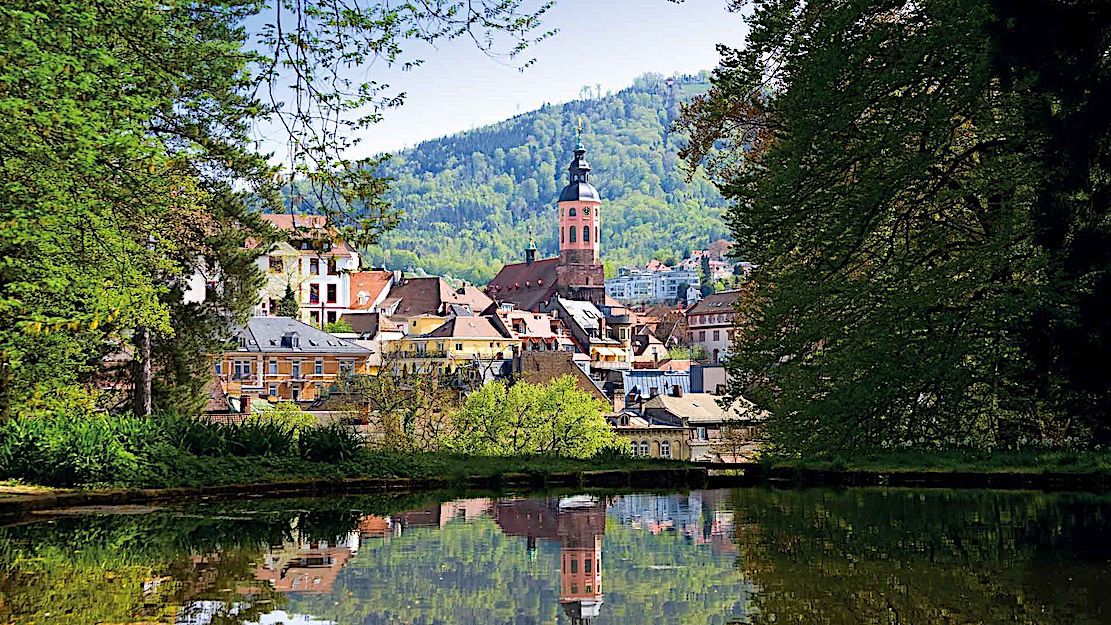
Baden-Baden in southern Germany is one
of the quietest major
cities in Europe, perhaps because its residents
are ever in awe of their good
fortune of living in the verdant Oos Valley,
surrounded by the majesty of the Black
Forest. In
homage, the city’s designers and
architects have always paid very close attention
to harmonizing the city to its
natural beauty, creating low-lying buildings
within gardens and alongside
streams and rivers whose silent movement makes
it one of the most romantic
spots in Germany.
 Almost untouched by
the Second World War, Baden-Baden was spared the
destruction of any of its
monuments, including Das Goldene Kreuz (the Golden
Cross), a gate that opens
onto a pretty shopping street, and the charming
buildings set around
Augustaplatz, Marktplatz and Leopoldsplatz in the
Old Town. There you’ll find
the Paradies, a hillside complex of gardens,
fountains and cascades—falling 130
feet—built in 1925 and served by an underground
spring.
Almost untouched by
the Second World War, Baden-Baden was spared the
destruction of any of its
monuments, including Das Goldene Kreuz (the Golden
Cross), a gate that opens
onto a pretty shopping street, and the charming
buildings set around
Augustaplatz, Marktplatz and Leopoldsplatz in the
Old Town. There you’ll find
the Paradies, a hillside complex of gardens,
fountains and cascades—falling 130
feet—built in 1925 and served by an underground
spring.
The city’s Walla-Walla-like
name is due to formerly being identified as the
city of Baden within the state
of Baden. Its growth and reputation in the 19th
century grew from the
therapeutic properties of its thermal baths, now
housed in a modern structure
of shimmering beauty built on the idea of Rome’s
Baths of Caracalla. The town
therefore attracted a large number of wealthy
Russian visitors, including
litterateur Leon Tolstoy, who set a scene in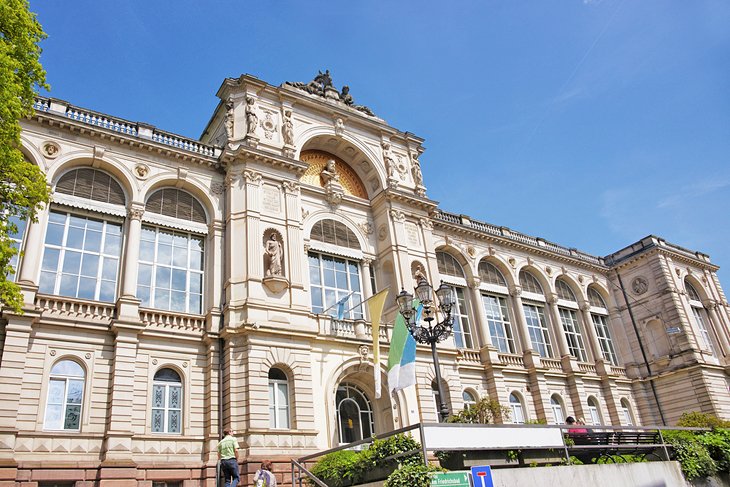 his novel Anna Karenina in a spa called Bad
Soden modeled after Baden-Baden,
while Ivan Turgenev, who suffered from gout,
visited the town and lived there
for six years, saying that the “magnificent trees
do wonders for the eyes and
soul.”
his novel Anna Karenina in a spa called Bad
Soden modeled after Baden-Baden,
while Ivan Turgenev, who suffered from gout,
visited the town and lived there
for six years, saying that the “magnificent trees
do wonders for the eyes and
soul.”
Some of the city’s
spas are magnificent examples of baroque
architecture, like the Friedrichsbad
(1877) with its 17stations, and the huge outdoor
Caracalla Spa with its curving
colonnade (right).
 Lichtentaler Allee
(below) is a beautiful park and arboretum
in the heart of town, sprawling for a mile
and a half along the Oos River, with an art
nouveau garden called the Gönneranlage, with more than 400 different types
of roses. Also within the city
is the Gothic Stiftskirche, the 17th
century Convent of the Holy
Sepulchre, and one of Europe’s finest opera
houses, the Festspielhaus,
with 2,500
seats, built in 1998.
Lichtentaler Allee
(below) is a beautiful park and arboretum
in the heart of town, sprawling for a mile
and a half along the Oos River, with an art
nouveau garden called the Gönneranlage, with more than 400 different types
of roses. Also within the city
is the Gothic Stiftskirche, the 17th
century Convent of the Holy
Sepulchre, and one of Europe’s finest opera
houses, the Festspielhaus,
with 2,500
seats, built in 1998.
There are three
unique museums in Baden-Baden. Dedicated
exclusively to 20th and 21st century
art, there is the Museum Frieder Burda, designed
by architect Richard Meier. It
is rich in works of German Expressionism, American
Abstract Expressionism and
has a superb collection of the later works of
Picasso. The Stadtmuseum surveys
ancient and classical art up through the 19th
century. The Fabergé Museum, only
13 years old,
is devoted to the Russian
jeweler Carl Peter Fabergé, with more than 700
pieces and the very last Fabergé
Egg ever produced.
Quiet
as the city is, the
activities there also have a calming effect on the
spirit, including trail
hiking, biking, a city train and funicular
railway, ballooning and visits to
nearby wineries. Sunsets can be stunning from
vistas at Merkur Mountain,
Battert Rock, the New Castle in Old Town and Hohenbaden Castle,
built in 1102.
There is a beach on the lake that is minimal but
very pleasant.
For a century and a
half, Brenners Park-Hotel & Spa (right)
has been
identified with the good life in Baden-Baden.
Beginning back
in 1872 as the hotel
Stéphanie-les-Bains, it was opened by a master
tailor to Pforzheim royalty
named Anton Alois Brenner, and over the decades
was expanded and rebuilt,
including acquisition of César Ritz’s Hotel
Minerva next door.
After World War Two, it changed names to
Brenner’s Park-Hotel & Spa, now within the
Oetker family.
the New Castle in Old Town and Hohenbaden Castle,
built in 1102.
There is a beach on the lake that is minimal but
very pleasant.
For a century and a
half, Brenners Park-Hotel & Spa (right)
has been
identified with the good life in Baden-Baden.
Beginning back
in 1872 as the hotel
Stéphanie-les-Bains, it was opened by a master
tailor to Pforzheim royalty
named Anton Alois Brenner, and over the decades
was expanded and rebuilt,
including acquisition of César Ritz’s Hotel
Minerva next door.
After World War Two, it changed names to
Brenner’s Park-Hotel & Spa, now within the
Oetker family.
Aside from the art that has
adorned its interior for decades, the
hotel also features changing modern art
exhibitions inside and outside. There
is a state-of-the-art spa where you can enjoy a
selection of saunas, take a
plunge into the icy Frigidarium pool, have
yourself stretched, pulled, walked
on, and colorized, as well as getting a
computer-generated inside look at your
feet that shows you how silly your walk is.
There is also an opportunity to tool around
in an Aston-Martin Vantage
or a VW Beetle and have a picnic in the forest.
There
is a state-of-the-art spa where you can enjoy a
selection of saunas, take a
plunge into the icy Frigidarium pool, have
yourself stretched, pulled, walked
on, and colorized, as well as getting a
computer-generated inside look at your
feet that shows you how silly your walk is.
There is also an opportunity to tool around
in an Aston-Martin Vantage
or a VW Beetle and have a picnic in the forest.
The hotel’s rooms are
beautifully maintained, with French windows
overlooking the lawn and lake, and range from
singles all the way up to a
six-bedroom Parkvilla with three living rooms and
private garden.
All of the hotel’s
restaurants have been redone, starting with the
beautiful Oleander Bar,  named
after
Baron Schlenderhan’s thoroughbred stallion, a
cushy and comfortable spot
to have cocktails before heading to dinner at the
airy Wintergarten, whose
setting is in a conservatory, with sliding windows
open to the therapeutic
Baden-Baden air. The canopy ceiling has
slow-turning fans, the black-and-white
tile floor and wicker bistro chairs make it all
the cheerier, and little red
lights cast a sweet glow on the tables.
named
after
Baron Schlenderhan’s thoroughbred stallion, a
cushy and comfortable spot
to have cocktails before heading to dinner at the
airy Wintergarten, whose
setting is in a conservatory, with sliding windows
open to the therapeutic
Baden-Baden air. The canopy ceiling has
slow-turning fans, the black-and-white
tile floor and wicker bistro chairs make it all
the cheerier, and little red
lights cast a sweet glow on the tables.
Chef
Alexander May’s
is a grand international cuisine that may begin
with ikarimi salmon with Thai salad
(€33) or foie gras “Heaven and
Earth” with caramelized soy shallots and apple
compote on potato mousseline
(€33); two vegetarian options; and Brenner’s
classics of Wiener Schnitzel (€41)
and for dessert the apple pancake with sour cream
ice cream (€19) or the pretty
iced soufflé Stéphanie with raspberry sauce (€19),
named by Camille Brenner,
who inherited the hotel from his father in 1881,
after his daughter.
Fritz & Felix is a
tad more casual restaurant, with a lighter menu by
Chef Farid Fazel that
includes gazpacho (€16), truffled brioche with
wagyu onglet (€28) and a good
number of grill items like red mullet (€42) and
even U.S. beef (€45).
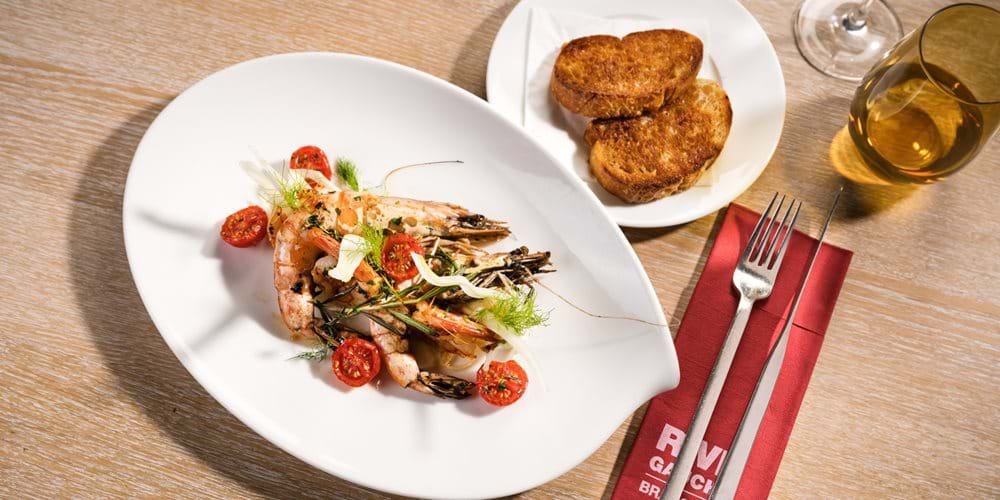 The
Rive Gauche
Brasserie (left) is a warm
and friendly spot for traditional classics like
tartare of
beef (€18), roast chicken for two (€59) and mousse
au chocolat (€11). The Kaminhalle is an
elegant setting for tea, while the
cigar lounge is for what it says it is. The
breakfast buffet in another dining
room is one of the most extensive and elegantly
presented in Europe.
The
Rive Gauche
Brasserie (left) is a warm
and friendly spot for traditional classics like
tartare of
beef (€18), roast chicken for two (€59) and mousse
au chocolat (€11). The Kaminhalle is an
elegant setting for tea, while the
cigar lounge is for what it says it is. The
breakfast buffet in another dining
room is one of the most extensive and elegantly
presented in Europe.
Baden-Baden has
plenty of good restaurants (several of the
old-timers have, however, closed),
both traditional, like the colorful
Restaurant Laterne in a 300-year-old
structure in city center; the
Bierbrunnen for German cooking; Heine’s Wine &
Dine; and the
Neapolitan-accented Mamma Lina Ristorante
Pizzeria.
You
have, then, two
options in Baden-Baden: Either go there to restore
your health in the waters,
or go there to enjoy fully the good life. The
baths will always be there next time.
❖❖❖
GALLAGHERS
228 West
52nd
Street
212-586-5000
Photos by Palm Beach Influence
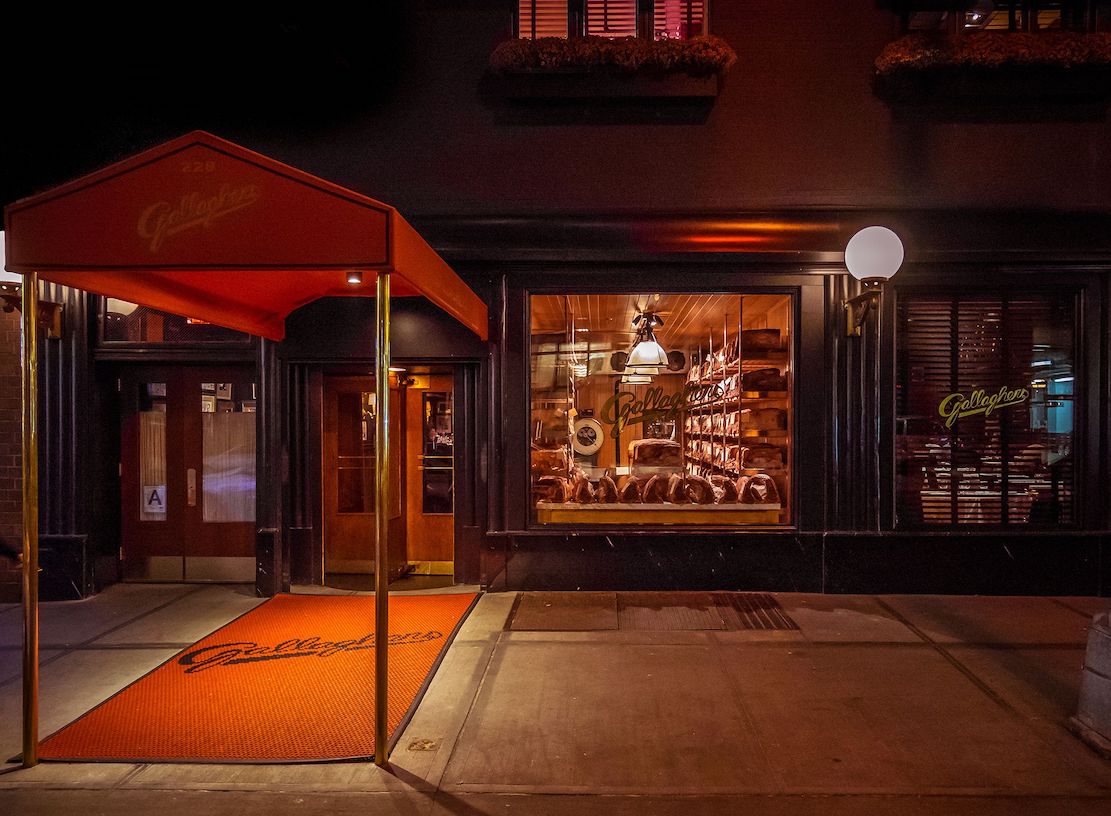
New
York, where the 20th
century steakhouse was invented, now has few
of the
original pioneers like Palm on Second
Avenue, Bruno’s Pen & Pencil, Christ
Cella and others. We still have Peter Luger,
Keens and The Homestead, and
plenty more that followed later, like Smith
& Wollensky, Wolfgang’s, Porter
House and a slew now owned by eastern
European immigrants.
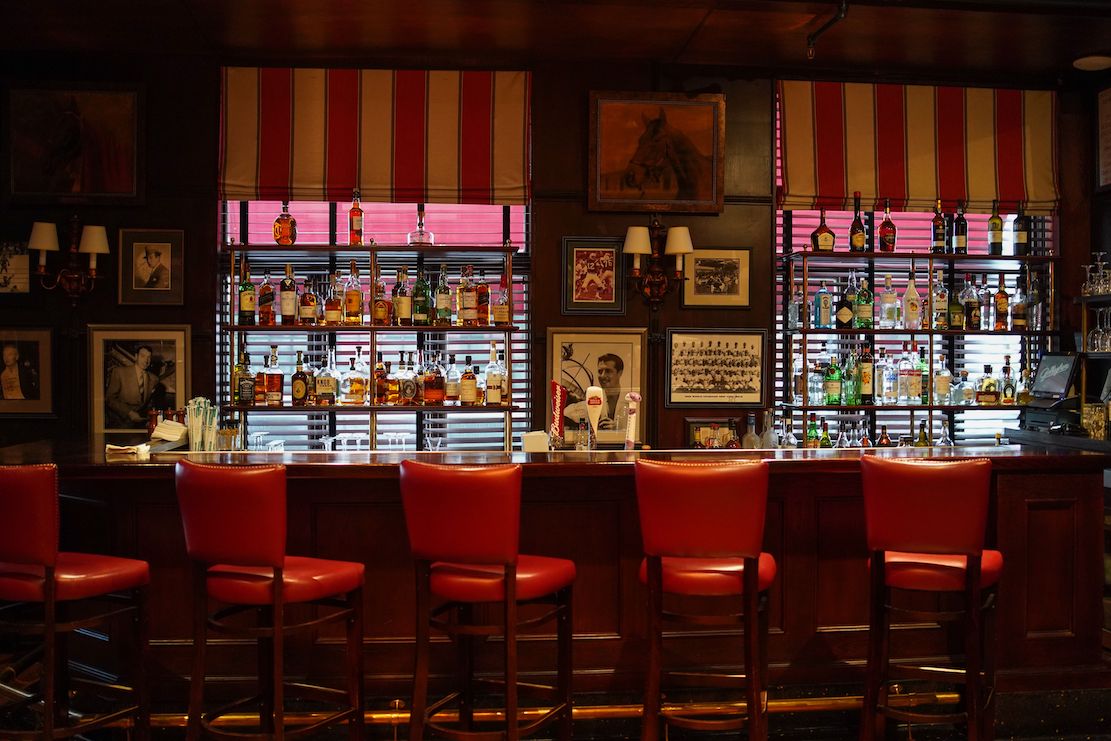 All are
vying for a decreasing amount of the best USDA
Prime beef that
had always distinguished New York, before the
Meat Packing district in Chelsea
was taken over by trendy (always empty)
boutiques. Don’t for a minute believe
that all the steakhouses in the U.S., or even
in New York, now get the same
quality of aged, marbled beef once available.
All are
vying for a decreasing amount of the best USDA
Prime beef that
had always distinguished New York, before the
Meat Packing district in Chelsea
was taken over by trendy (always empty)
boutiques. Don’t for a minute believe
that all the steakhouses in the U.S., or even
in New York, now get the same
quality of aged, marbled beef once available.
Fortunately,
such a lament does not apply to Gallaghers,
whose beef carcasses hang in a
cold locker for all to see from the street,
aging there for at least 21 days,
darkening, losing moisture and getting a touch
moldy on the outside—all factors
that make for a corn-fed cut of beef.
Add to that the fact that the grilling
over hickory wood has been honed
over eight decades, along with the preparation
all the other staple items on
the menu, and you’ve reason enough to go to
Gallaghers for a great meal.
Testament to the quality of the beef is
my long-time butcher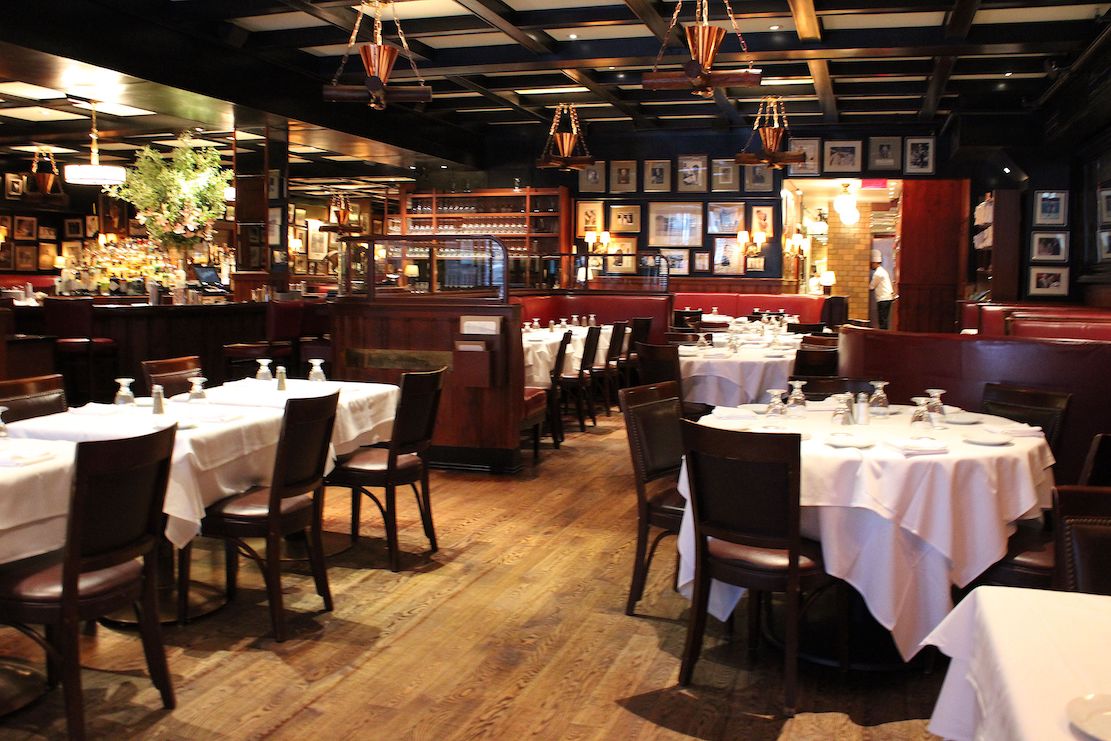 saying
that Gallagher’s is one of the few places in
New
York where he eats beef.
saying
that Gallagher’s is one of the few places in
New
York where he eats beef.
But there’s more. Gallaghers has a
raffish West Side history fitted
impeccably to the legends of Broadway and the
sports world who have dined
there, as they once would have gone to Toots
Shor’s, Jack Dempsey’s, Billy the
Oysterman, Reuben’s, the Russian Tea Room and
Sardi’s, of which only the last
two are still open.
The story begins during Prohibition,
when former Ziegfeld girl Helen
Gallagher and gambler, later husband, Jack
Solomon opened a speakeasy that was
quickly turned into a Broadway area steakhouse
when liquor
became legal again. Right from the start it
attracted show biz and sports
people who brought memorabilia to be hung on
the walls.
When
Helen died, Jack married florist Irene
Hayes, and when Jack died, Irene took over
until selling to veteran
restaurateur Jerome Brody, who installed the
meat locker windows as of 1964.
Brody’s widow
Marlene took over and
commissioned cartoonist Peb Pierre Bellocq to
create the “Canvas of Stars”
mural, which she still owns after selling
Gallaghers in 2013 to Dean Poll, who
completely renovated the place.
There
have been times in Gallagher’s history when
the kitchen dropped
the ball, the waiters trudged through the
motions and the greeting at the door
could be dour. And before the purchase and
rehab by Poll (who until recently
ran the Loeb Boathouse in Central Park; he’s
also got a Gallaghers in Las
Vegas), the place needed a good hosing down.
Now, without changing much of anything
you’d notice, Gallaghers is
again unique for its sprawl, its sometimes
raucous bar, its well-set tables and
booths and enough sports and showbiz
paraphernalia to fill the Museum of the
City of New York and
the New-York
Historical Society. Gallagher’s is where the
new draft picks were announced,
and press conferences for Madison Square
Garden fights and sports movies would
be held.
Waiters look trim in their black
jackets (some trimmer than others) and their
choreographic interplay with the kitchen, the
bus boys and the rolling food
carts adds to the whirl as your waiter
announces the night’s specials, which
are considerable and out of the ordinary for a
steakhouse. And they’ll tell you
if there’s just one or two portions of a dish
left. (I missed out on the last
slab of Prime rib by seconds!) The restaurant,
which gets lunch, matinee,
pre-theater, during-theater and after-theater
crowds, can be very loud around
seven o’clock, though by nine the din dies down a bit.
Gallaghers' appetizers are mostly those
you’ll find elsewhere, including
a first-rate jumbo lump crab cake (left)
with cucumber salad ($25) that really did
contain a lot of jumbo crab. More unusual and
quite well done were plump shrimp
and lobster dumplings with a soy-ginger sauce
($18). But there are also those
specials, and this being summer, one was a
refreshing, very sweet watermelon
salad with feta cheese ($15). Vichyssoise
($12) sounded like a good idea,
though aside from its cool creaminess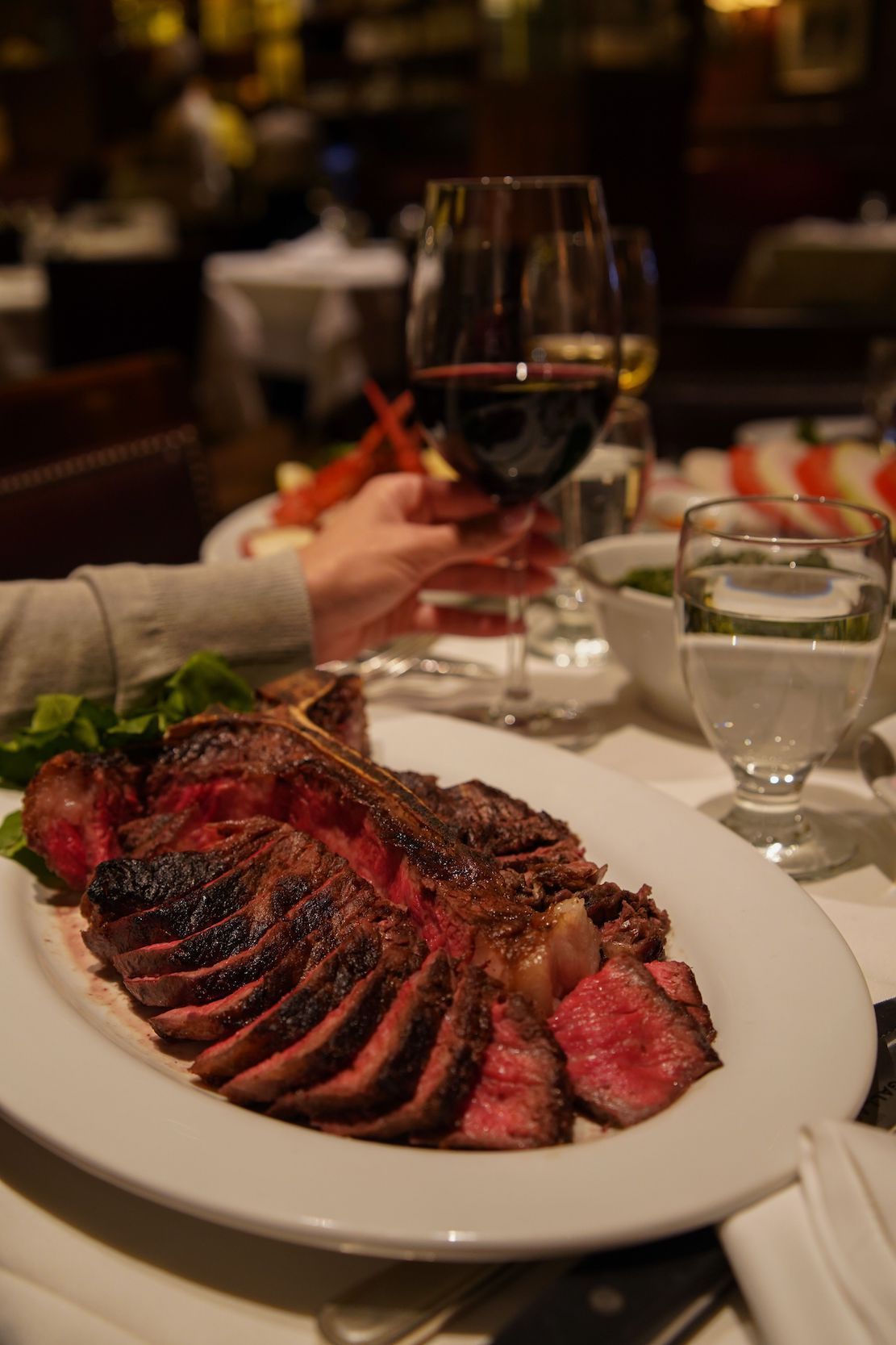 didn’t have a lot of potato or leek
flavors.
didn’t have a lot of potato or leek
flavors.
The menu’s Steaks & Chops section
is as large as that for Seafood,
beginning with a superbly charred, medium-rare
porterhouse ($65 per person) cut
for two, three or four people. Equally fine
were three Colorado lamb chops
($65) that were perfectly trimmed so as to
leave sufficient sweet fat on
them.
Dover sole (MP) was a special that
evening, and the nice fat specimen,
cooked with plenty of good butter, equaled any
I’ve had in the best French
restaurants in New York, London or Paris.
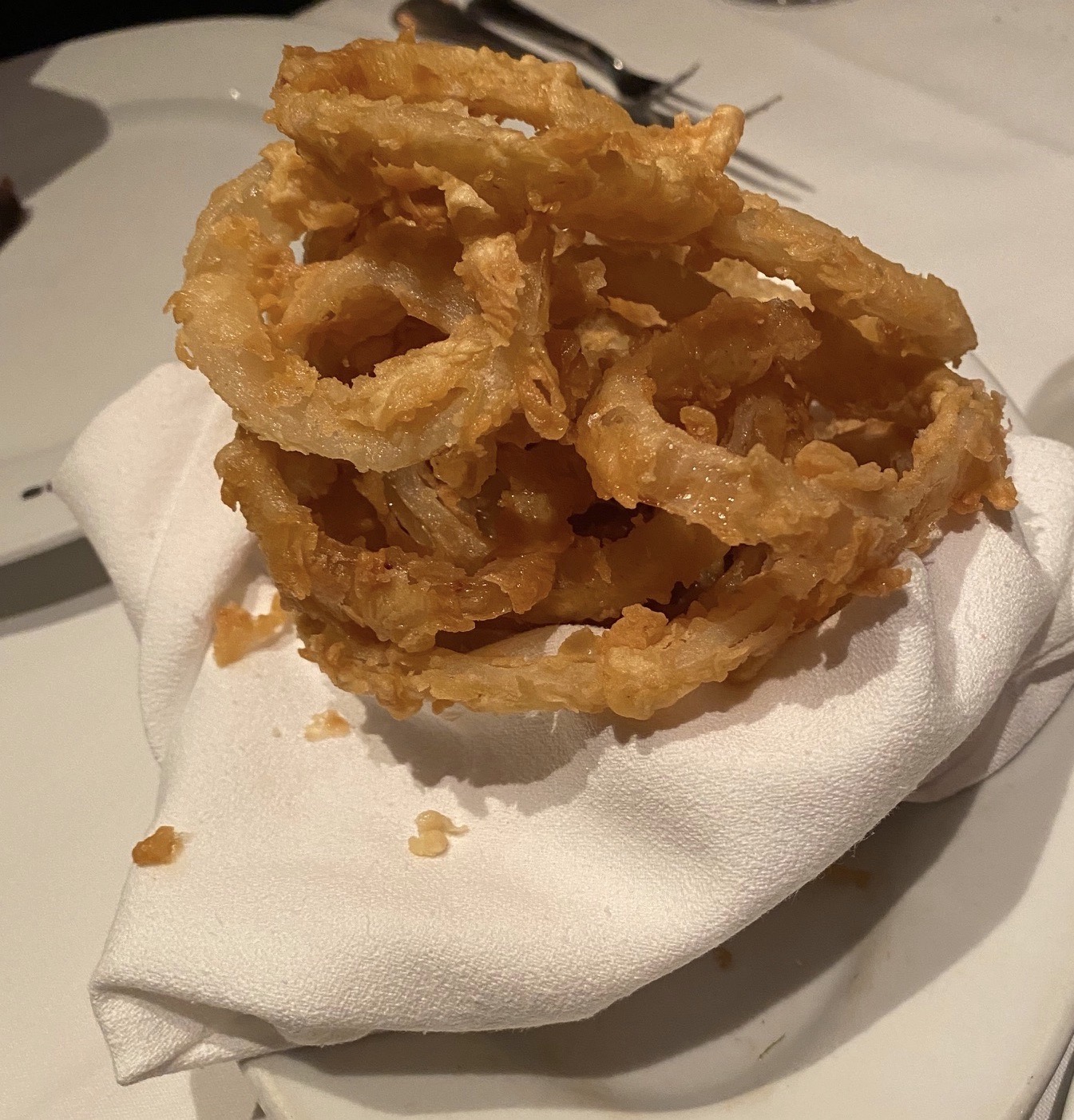 An
abundance of sides include a hefty portion of
hashed brown potatoes ($13) our
table of four ate with relish and still took
some home, as we did the carefully
sautéed spinach ($15). Despite the grand
portion of onion rings ($13), we
demolished them, incapable of restraint when
they came so well-crusted and
tasting so much of sweet onions.
An
abundance of sides include a hefty portion of
hashed brown potatoes ($13) our
table of four ate with relish and still took
some home, as we did the carefully
sautéed spinach ($15). Despite the grand
portion of onion rings ($13), we
demolished them, incapable of restraint when
they came so well-crusted and
tasting so much of sweet onions.
The wine list at Gallaghers has a long
pedigree, stressing American
reds. Mark-ups are north of 100 percent, and
there are not many bottles under
$100.
Desserts at steakhouses toe a
traditional line, and they usually range
from okay to pretty good. Those at Gallaghers
(all $12) are so much so that I
might even consider coming here after theater
just for a slice of the thick,
not-too-sweet pecan or apple pies or the
summery strawberry shortcake (right),
even
that bistro favorite profiteroles with
chocolate sauce. 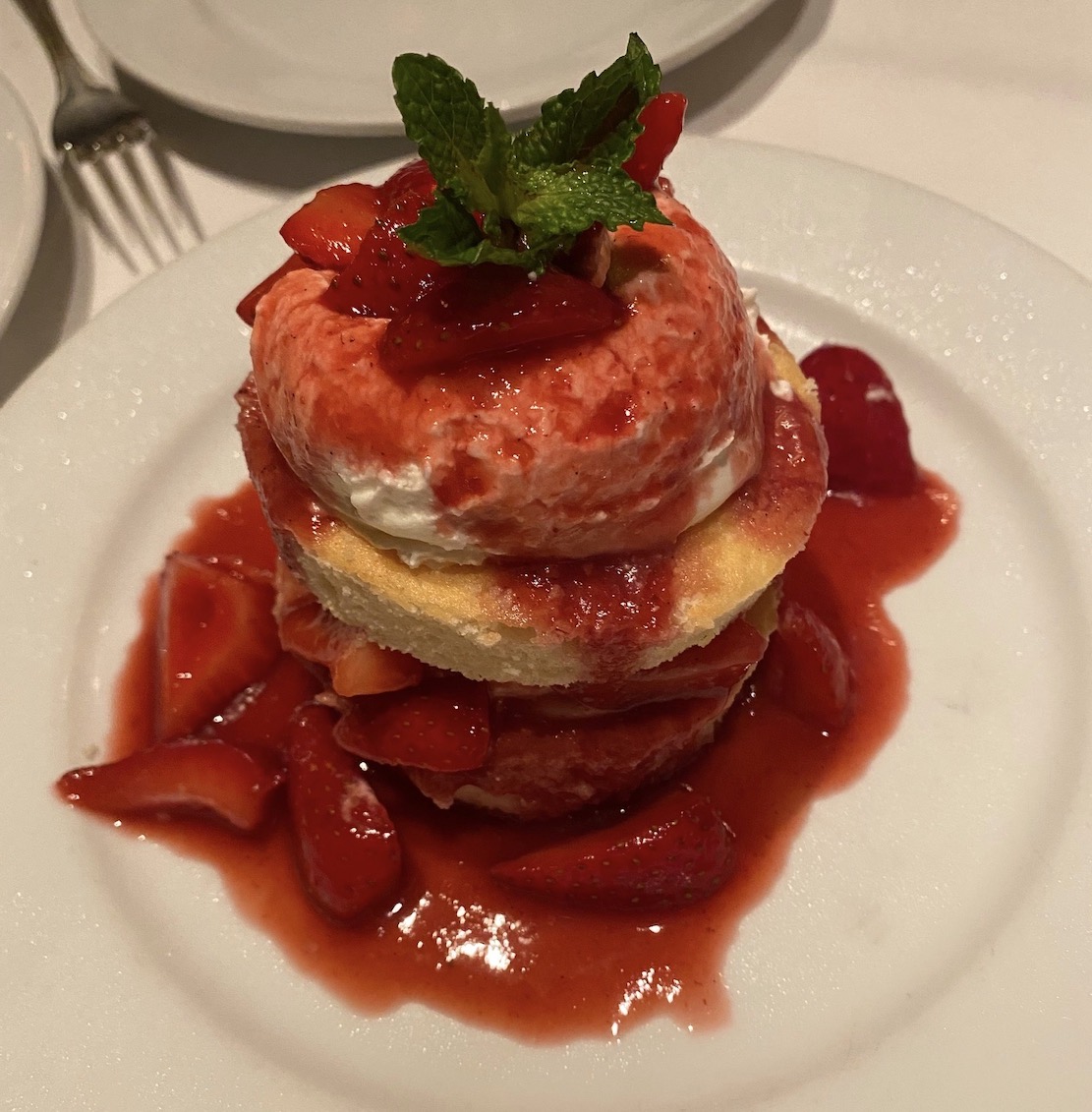
While finishing
my meal, I found myself wondering, if Paul
Bocuse, Roger
Vergé and Alain Ducasse sat down and ate at a
table at Gallaghers, what would
they say? I suspect they would have just
looked at each other, nodded and said,
“C’est
magnifique!” And well they
should; everyone else does.
Open
daily for lunch and dinner.
❖❖❖
ANOTHER VERMEER


All three experts
expressed
disappointment in not having more time to do
their work, for it was now October
and their contract called for a full report
within a month.
O’Keeffe was as good as his word and
contacted Derrick
Donaldson at Crofthouse, who said it was fine
for Katie to call him.
“I asked him if the shit hit the fan
with the announcement
that Crofthouse
got the sale,” said
O’Keeffe. “He said there was a lot of media
attention, both in China and
Taiwan, but that the big collectors had not
yet registered. He didn’t seem
surprised by that, yet, but they would have to
soon.
“Then
again, I can’t imagine how many
bidders there will be on a painting of this
value. When prices get that high,
they call it the ‘nosebleed zone.’ Who knows,
maybe some of the museums will
have emissaries hoping by some fluke that the
big collectors don’t show up.”
Derrick Donaldson seemed pleased to get
Katie’s call and
told her what he’d told O’Keeffe. What Katie
wanted to know was how much the
Chinese might have told Crofthouse about the
painting’s provenance.
 “I
must admit, not much,” said Donaldson, who had
an
uppercrust British accent, with the slight but
deliberate stutter. “They told
us that from what they knew the painting had
been in Beijing for as long as
anyone knew. They assumed it arrived in China
back in the 17th century, at a
time when there was next to no western art in
Asia outside of what the British
and the Dutch brought with them to India and
China to decorate their own homes.
I have seen some minor landscapes and some
hoary old portraits from the days of
the Raj, but nothing on the order of a
Vermeer.”
“I
must admit, not much,” said Donaldson, who had
an
uppercrust British accent, with the slight but
deliberate stutter. “They told
us that from what they knew the painting had
been in Beijing for as long as
anyone knew. They assumed it arrived in China
back in the 17th century, at a
time when there was next to no western art in
Asia outside of what the British
and the Dutch brought with them to India and
China to decorate their own homes.
I have seen some minor landscapes and some
hoary old portraits from the days of
the Raj, but nothing on the order of a
Vermeer.”
“Well,” asked Katie, “does that make
you
a little skittish?”
“Skittish? Hm, not a word we use much
here. I’d say we want
to be very careful and ask all the right
questions. It’s our reputation on the line, of
course. To that end we’re bringing
in three of the world’s finest Vermeer
specialists to examine the painting.”
Katie took pleasure in reeling off the
experts’ names and
saying she’d already spoke with all of them.
“Well, then,” said Donaldson, “You may
know more than I do.
They’re very tight-lipped, as they should be
until they finish their research.
I do know they are working very hard and very
long hours.
The painting is here at our offices,
all very
secure, of course.”
Katie turned the discussion to the
potential bidders, again
reeling off the six whom she’d been following,
not mentioning the late Mr.
Saito.
“My lord, you really have done your
homework, Ms. Cavuto.
Yes, those are all A-list names in this
firmament.”
“And you haven’t heard from any of them
yet?”
“No, but it’s a little early. Often
collectors of this order
try to feel each other out about a big sale,
do their own research, ask their
own experts. I’m sure they’ll come around,
although I hear this fellow
Stepanossky had a bit of an accident that took
off most of his foot.”
“That’s what I’ve read,” said Katie.
“He may not feel much
like bidding in November.”
“That would be a loss. He’s as rich as
any of them. You know the Russians. Swiss
banks are bulging with Russian money.
They had to convert new rubles to dollars to
do it, and that hasn’t been easy.”
Katie asked a few more questions,
thanked him, and wished
him luck with the sale. Donaldson said, “We
are in unchartered waters here, you
know. This could open up China in so many
ways. It will have geo-political
ramifications. Well, in any case, it’ll be
fun, won’t it?”
Katie knew that Donaldson
had every right to be giddy,
since, if this auction went well, his company
would be the most likely to be
the lead house for whatever else the Chinese
planned to sell.
Just
two days late, the authentication
report by the three experts was given to the
principals at Crofthouse. The
report was very lengthy, more than 150 pages,
treating every aspect of the
painting, from the condition to the origins of
the canvas and frame, along with
analysis, as much as was possible, of the
pigments used, which paint colors may
not have existed back in the 17th century.
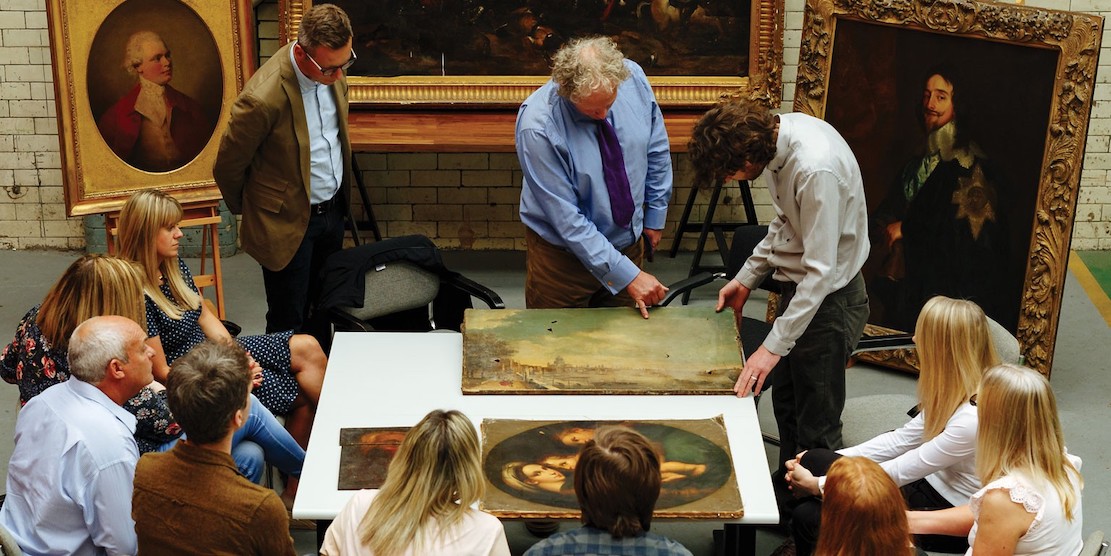 The x-rays seemed to show no
significant underpainting,
nothing that differed from the final design
used. Marie-Céline Bourget did
question the painting of the folds of fabric
on the figure’s right arm and
concluded that at some point the original
paint had been compromised long after
the work was finished, and painted over, which
explained the lack of
“refinement” she’d mentioned, as well as
paints from a later date.
The x-rays seemed to show no
significant underpainting,
nothing that differed from the final design
used. Marie-Céline Bourget did
question the painting of the folds of fabric
on the figure’s right arm and
concluded that at some point the original
paint had been compromised long after
the work was finished, and painted over, which
explained the lack of
“refinement” she’d mentioned, as well as
paints from a later date.
There was a consideration of provenance
without a paper
trail, except that certain documents in the
Netherlands mentioned that Vermeer
might have agreed to do a third scientist as
part of a triptych but without
proof that it was ever done or sold. With help
from Chinese archivists they
found mention of “certain works of art
received from the West during the early
years of the Qing Dynasty,” which ruled China
from 1644 to 1912. The
works were not further identified or
described.
The final summary of the report,
written in English and
translated into Chinese, said:
After thorough
examination of the painting in dispute, the
committee feels confident that it
is indeed by Johannes Vermeer, painted
around 1665, perhaps as part of a
triptych of two similar works in which the
artist used the same model and the
same room for the background.
The committee
wishes to insist, however, that in other
circumstances, its report would be
considered as preliminary to a more in-depth
examination that might involve
further scientific testing in order to reach
an even firmer conclusion.
We certify that
this report was done with as much
exactitude, precision and impeccable
historical research as
was possible
within the schedule of its completion, so
that in the unanimous opinion of this
committee, the painting known as The
Chemist or The
Alchemist is
authenticated for sale by the People’s
Republic of China through the Crofthouse
Auction Company, Ltd, of Hong Kong in the
People’s Republic of China.
The report was signed, with varying
degrees of flourish, by
the three art experts, as well as Crofthouse’s
and the Chinese authorities’
attorneys and witnesses.
Art
Today did not
get an exclusive on the report—all other media
knew it was coming—but Coleman
and his staff did due diligence in calling the
other most important auction
houses for comments, all of which were
standard issue boilerplate to the effect
that they hoped the sale went well for all
concerned.
Coleman
knew, of course, that some of the
prospective bidders—those left in the
running—had in the past been customers of
Sotheby’s or Christie’s, and that if they were
going to bid, it was an open
field as to how to arrange for participation,
since sales to private collectors
of paintings of such rarity and value were
almost always kept secret. Sometimes
the collectors never revealed they
were the owners; other times, as with the late
Ryoei Saito, the owner might
brandish his ownership as a measure of pride
and power. In the case of what had
now been declared an authentic Vermeer, no one
in the art world could be sure
the buyer would ever be revealed. But the
price would.
© John Mariani, 2016
❖❖❖
NOTES FROM THE SPIRITS LOCKER
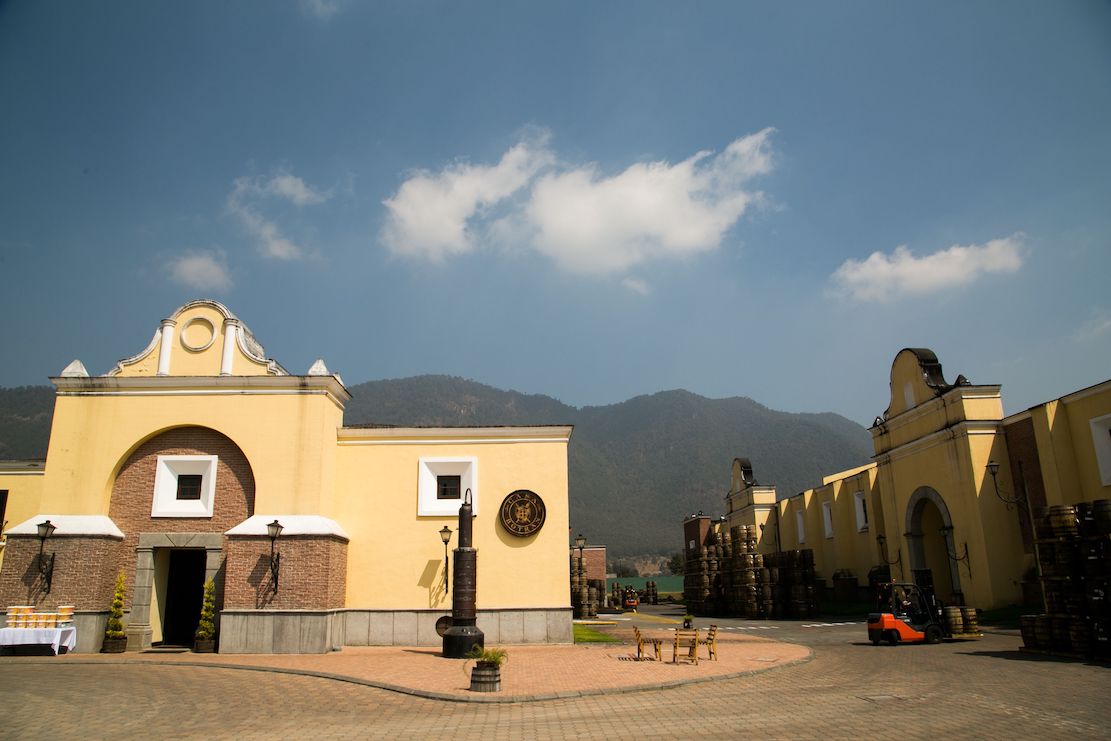
By John Mariani
Interest
in diverse rums beyond the white variety
that is the basis for so many cocktails has
been growing as new rleases come on
the market from traditional regions like the
Caribbean to unexpected sources like
the Philippines, India and the Czech
Republic. One of the best-known Guatemalan
brands has been Botran, which chose to get
out of the market for two years and now
returned with its own new approach to a more
sophisticated market. To find out more I
interviewed Botran's Ivan Valdez, senior
global brand manager for Licores de
Guatemala.
Botran is now back in the U.S.
market
after three years. Why the hiatus?
As
Guatemala’s top-selling aged rum, representing
Guatemala in over 50 countries
around the world, we took some time to revisit
our brand and market
strategy. At a global scale, we elevated
our vision to “to fill every
glass with the bright and vibrant spirit of
Guatemalan rum,” resulting in a
fresh look and new certifications that
highlight the brand’s provenance and rum
mastery. Subsequently, our in-market
strategy led us to a quest to find
the partner with the capability and drive to
position Botran Rum in the premium
segment. Thus, our refreshed brand,
solid credentials and strong partner
make it the perfect timing for a reinsertion
to achieve sustained growth in the
U.S. market.
What are the new
certifications?
•
Botran is Guatemala´s top-selling aged
rum with the Protected Designation of Origin
(PDO) of “Ron de Guatemala”
•
ISCC PLUS (International Sustainability
& Carbon Certification) accreditation,
certifying Botran as the world’s
first sustainable rum across all parts of the
rum journey, including
plantations, mill, distillery, ageing
facilities, and bottling
•
Certified Carbon Neutral from SGS in
recognition of Botran´s house
Guatemalan
Spirits commitment to our planet. Since 1977
Guatemalan Spirits has planted and
grown more than 1.8 million trees in
Guatemala. (Consequently, it
self-mitigates its carbon footprint without
the need to purchase carbon
credits.)
What does sustainability mean
vis-à-vis
rum production?
In
2019, Botran was awarded ISCC PLUS by the
International Sustainability Carbon
Certification, thus becoming the first
sustainable rum in the world to become
sustainable throughout the entire rum-making
process (social, harvest,
distilling, ageing, bottling) rather than a
section of the rum journey.
Thus, we carry our “ISCC” seal proudly on
every back label of our products;
moreover it is a commitment to sustainable
practices such as:
•
Facilities equipped with the right
conditions for our workers to grant their
safety and well-being
•
Reforestation
•
Water management - More than 96% of
water used in our mill is recycled
•
Waste management – we use cane bagasse
to produce clean energy
•
Clean energy - we use biogas, reducing
our fossil fuel use by 40-50%
 Is the
San Andres distillery the same
one used by Zacapa?
Is the
San Andres distillery the same
one used by Zacapa?
Yes,
Botran and Zacapa share the same distillery.
But please note that
Botran uses different sugar cane,
has its own aging facility in Xela,
Quezaltenango, and has three female
Master Blenders that only work on
Botran rums: Magda López, Master Blender
and Ageing Facility Manager;
Yazmín Chapeton, Master Blender and Head of
Manufacturing & Blends;
Leslie Taracena, Master Blender and Blend
Researcher & Coordinator.
Ivan Valdez, senior
global brand manager for Licores de
Guatemala.
What is Botran’s “Dynamic Ageing
System”?
Botran’s
Dynamic Ageing System is actually more complex
than a traditional solera
system. Instead of using the customary solera
pyramid structure, we’ve created
a vintage stacked system that works in
vertical columns. Over the years, our
three Master Blenders have perfected this
aging regimen, elevating it to an art
form. Different
types of casks are used in each column to keep
the process dynamic, with a
focus on amplifying flavors and aromatics.
As our rums are blended, the
casks are repositioned, and the process is
repeated. Over time, the younger
rums take on the big, bold flavors and
distinct personalities of the aged rums.
Each blend is created to specifically
highlight desired characteristics. This
is an adapted solera system that adds
complexity, and creates roundness and
homogeneity across the Botran portfolio.
Is the rum market increasing in
sales
and number of rums entering the market?
In
2021, the total rum market in the U.S. reached
a total volume of 198 million
liters. While the standard and value
segments in rum are decreasing (5-year
compound annual growth rate of -1%), growth is
coming from the segments at
higher tiers. That is the premium, super
premium, ultra-premium, prestige
and prestige plus segments with a 5-year CAGR
of 4%, 20%, 22%, 10% and 44%,
respectively.
Rum prices have been
relatively moderate by comparison to many
other brown spirits. Why?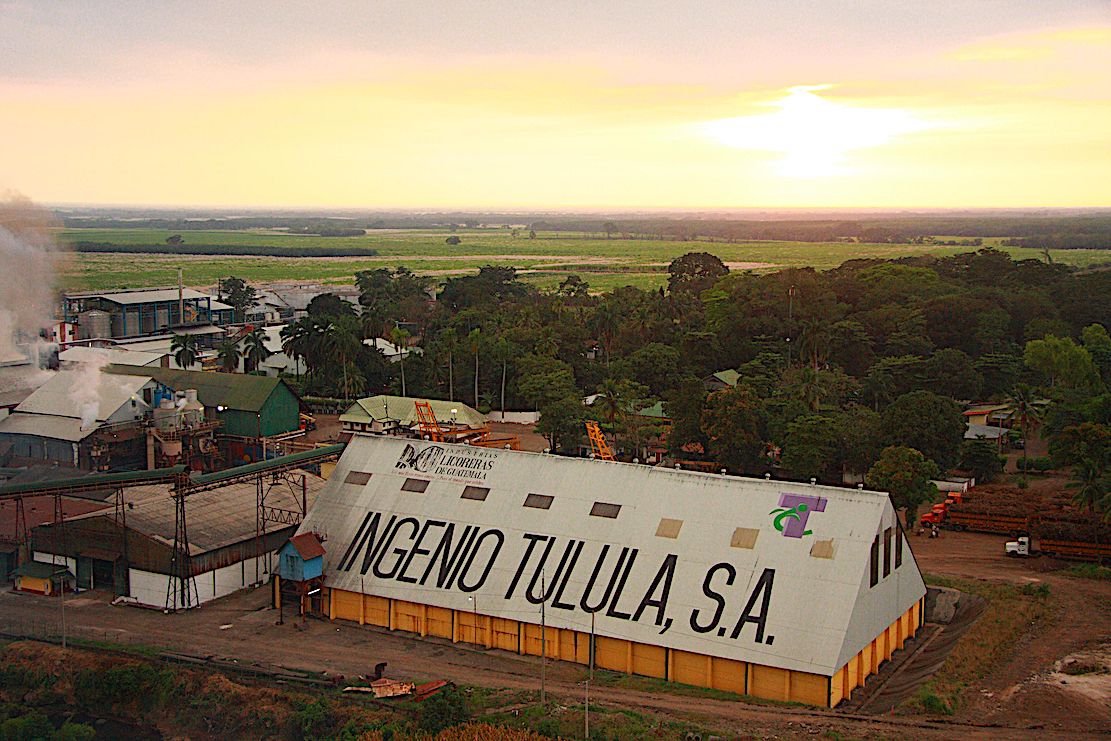
For years, rum consumption has
been tied mainly to classic
cocktails (mojito, rum and coke, piña
colada) leveraging on great mixability
and sharing fun moments. Thus, still
in 2021, 94% of the rum volume sits
in the standard and value price segments
(USD 22.49 and below). In
contrast, those segments represent 57.4% for
the whisky/whiskey category – a
category primarily associated to a moment of
reward and “on the rocks”
drinking.
While rum
has evolved and we see a growing trend in
premium, as a
category, we have the challenge to change
rum’s perception over the coming
years from a mixable spirit used in
cocktails to a premium spirit of
distinction. Thus, more sipping-rum
premium experiences and innovation
will come in the future leveraging terroir,
aging process, and
barrel-types. This will foster a
higher sense of connoisseurship and
appreciation over the truth behind rum and
create more premium-rum-lovers as
they unveil the craftmanship and uniqueness
behind rums across the
globe. In the coming years, dark rum
will continue to see growth in high
price tiers with a 2021 to 2026 CAGR of 7%,
13%, 6%. 11% in the super premium,
ultra-premium, prestige and prestige plus
segments respectively.
 How
would you distinguish between a
Guatemalan rum and one from other regions in
the Caribbean?
How
would you distinguish between a
Guatemalan rum and one from other regions in
the Caribbean?
Guatemalan
rum has a Protected Designation of Origin,
which is safeguarded by the National
Association of Alcoholic Spirits Beverage
producers of Guatemala. It has been recognized
in 32 countries, including those in the
European Union. Guatemalan rum style is
unique from crop to drop and it all happens in
Guatemala:
•
Our terroir has vertisol soils, which
can only be found in 2% of planet earth.
•
We are a Guatemalan rum and use two
varieties of sugar cane which are only used
for Botran Rum: Chapina and
Preciosal
•
We do not use molasses (a byproduct of
sugar production). We use the virgin
honey which comes from the first
crush of sugar cane – a highly concentrated
sugar cane juice.
•
We slow-age in altitude in the
mountains
of Guatemala at 2,300 meters above sea level.
•
We have a distinctive dynamic ageing
system, locally developed and inspired by the
traditional solera ageing system.
Do you have a visitor’s center
and
tasting room? If so, can you tell me about
it?
Yes,
we do. We invite interested guests to learn
more about the Casa Botran
Experience
at https://botranrum.com/casa-botran-experience/.
Guests can
book tours to learn about our rums,
production, aging and more than 80 years of
our history. Tastings are available as
part of the Casa Botran
Tour.
Are your various aged rums
better for
sipping or are they good for mixing?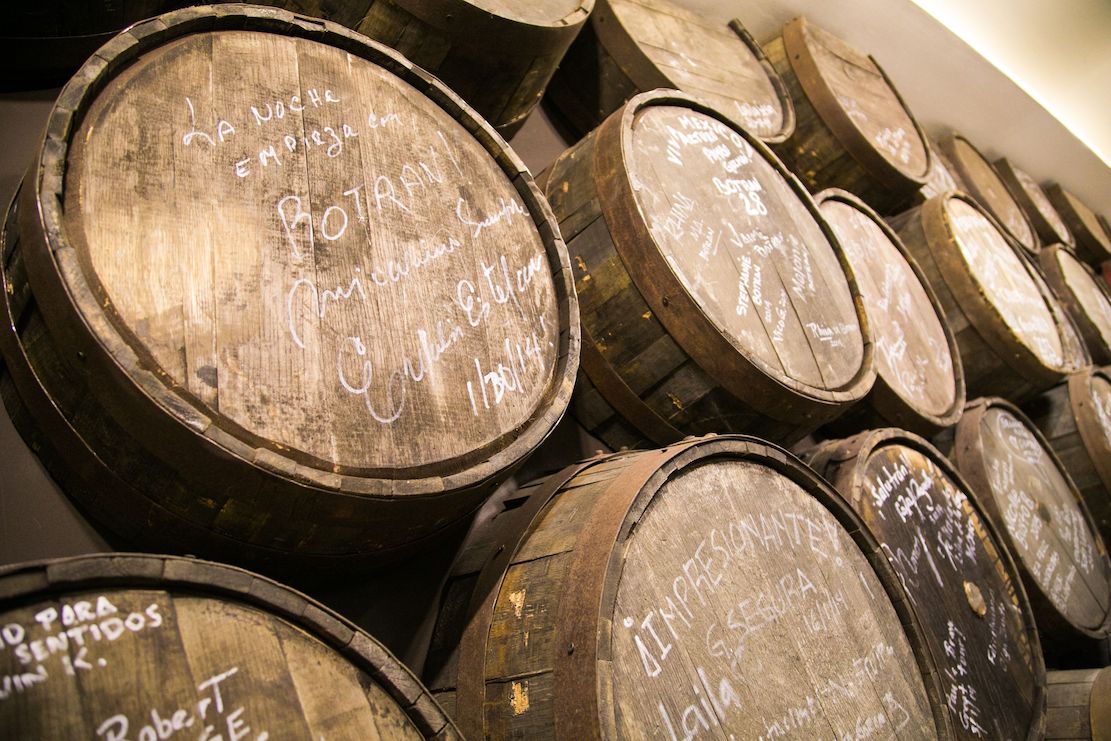
While
we believe everyone should enjoy our rums
however they best like, we tend to
suggest our Reserva Blanca and No. 8 rums for
mixing. The Reserva Blanca was
specifically made at the request of bartenders
who wanted an aged rum profile
to work with but didn’t want color to get in
the way of creating vibrantly
colored cocktails. We’ve employed a
special activated charcoal filtration
process that removes color but maintains
taste. Botran’s No. 12 is an ideal
choice for someone looking for a more
sophisticated yet versatile rum that can
bridge cocktails or sipping. For those who
enjoy sipping on rums—neat or with
ice—Botran’s No. 18 and No. 15 are especially
outstanding options when it comes
to savoring our cane spirits. These two in
particular have been aged using
ex-sherry and ex-Port casks, providing subtle
shades of flavors and aromatics
that are best enjoyed on their own.
Rum prices have been relatively
moderate by comparison to many other brown
spirits. Why?
Long-gone
is the time where rum was the spirit of
pirates. Rum evolved and the
growing trend in the higher tiers segments
responds to a higher interest of
consumers in premium rum. A higher sense
of connoisseurship and
understanding the truth behind spirits is
creating more rum-lovers as they
unveil the craftmanship and uniqueness behind
premium rums across the
globe. This makes our vision to “to fill
every glass with the bright and
vibrant spirit of Guatemalan rum” a bigger
commitment to the world.
Scotches and bourbons are
increasingly
being marketed as small batch and finished
in special barrels. Has Botran
any such intentions?
The
use of special barrels has been our specialty
since 1940 and is a distinctive
trait in our dynamic ageing system.
We use up to four special
barrels for our No.18 and No.15, three special
barrels for our No.12 and No.8
and two special barrels for our Reserva
Blanca.
Nonetheless,
we took our rum mastery to another level,
releasing a Rare Blend bottling.
These are limited editions that include Botran
Rum finished in a fifth special
cask. Most recently, we released Botran
Rare Blend Guatemalan Oak (for
the European market) and Botran Rare Blend
Vintage Wine Cask (for travel
retail), which featured a blend of rums aged 8
to 25 years that were finished
in a very special cask. Right now, Rare Blend
only goes to select markets.
Since the Caribbean is so hot
and
humid, does climate change have any effect
on the plantations?
Climate
does have an effect on plantations, mainly
shifting harvest seasons.
Nonetheless, we use advanced technology and
work together with Guatemala’s
Climate Change Institute to plan ahead and
continue delivering the great
quality that represents our protected
designation of origin: Ron de Guatemala.
What are the threats from
hurricanes?
Hurricanes
are unprecedented events that rarely affect
the southern area of Guatemala. Up
until today, we have never been directly
affected by such a natural threat, as
our facilities are located precisely in this
area of the country.
What other countries is Botran
sold in?
In
addition to the U.S., you can find Botran Rum
in more than 50 countries such as
Guatemala, El Salvador, France, Italy, Mexico,
Spain, Germany, Peru, Costa
Rica, Colombia, Czech Republic, Panama,
Croatia, Netherlands, Denmark, Canada,
Honduras, Sweden, Israel, Belgium,
Switzerland, Australia, Greece, etc.
❖❖❖
 OUR
INTREPID RESTAURANT CRITICS
OUR
INTREPID RESTAURANT CRITICS
“For seating,
there were
two tables on the sidewalk, but nothing to protect
them from the intense sun.
Inside, I shared a tiny counter with a fan meant to
supplement a struggling
A.C. unit, no match for the humidity. And yet, the
ribbon of fiery spice
running through almost every dish tempered the
steamy climate, like drinking
hot tea.”— Hanna Goldfield, “Queens Lanka,” The
New Yorker (8/1/22)
❖❖❖
Any of John Mariani's books below may be ordered from amazon.com.
 The Hound in Heaven
(21st Century Lion Books) is a novella, and
for anyone who loves dogs, Christmas, romance,
inspiration, even the supernatural, I hope you'll find
this to be a treasured favorite. The story
concerns how, after a New England teacher, his wife and
their two daughters adopt a stray puppy found in their
barn in northern Maine, their lives seem full of promise.
But when tragedy strikes, their wonderful dog Lazarus and
the spirit of Christmas are the only things that may bring
his master back from the edge of despair.
The Hound in Heaven
(21st Century Lion Books) is a novella, and
for anyone who loves dogs, Christmas, romance,
inspiration, even the supernatural, I hope you'll find
this to be a treasured favorite. The story
concerns how, after a New England teacher, his wife and
their two daughters adopt a stray puppy found in their
barn in northern Maine, their lives seem full of promise.
But when tragedy strikes, their wonderful dog Lazarus and
the spirit of Christmas are the only things that may bring
his master back from the edge of despair. WATCH THE VIDEO!
“What a huge surprise turn this story took! I was completely stunned! I truly enjoyed this book and its message.” – Actress Ali MacGraw
“He had me at Page One. The amount of heart, human insight, soul searching, and deft literary strength that John Mariani pours into this airtight novella is vertigo-inducing. Perhaps ‘wow’ would be the best comment.” – James Dalessandro, author of Bohemian Heart and 1906.
“John Mariani’s Hound in Heaven starts with a well-painted portrayal of an American family, along with the requisite dog. A surprise event flips the action of the novel and captures us for a voyage leading to a hopeful and heart-warming message. A page turning, one sitting read, it’s the perfect antidote for the winter and promotion of holiday celebration.” – Ann Pearlman, author of The Christmas Cookie Club and A Gift for my Sister.
“John Mariani’s concise, achingly beautiful novella pulls a literary rabbit out of a hat – a mash-up of the cosmic and the intimate, the tragic and the heart-warming – a Christmas tale for all ages, and all faiths. Read it to your children, read it to yourself… but read it. Early and often. Highly recommended.” – Jay Bonansinga, New York Times bestselling author of Pinkerton’s War, The Sinking of The Eastland, and The Walking Dead: The Road To Woodbury.
“Amazing things happen when you open your heart to an animal. The Hound in Heaven delivers a powerful story of healing that is forged in the spiritual relationship between a man and his best friend. The book brings a message of hope that can enrich our images of family, love, and loss.” – Dr. Barbara Royal, author of The Royal Treatment.
 |
The Encyclopedia of American Food and Drink by John F. Mariani (Bloomsbury USA, $35) Modesty forbids me to praise my own new book, but let me proudly say that it is an extensive revision of the 4th edition that appeared more than a decade ago, before locavores, molecular cuisine, modernist cuisine, the Food Network and so much more, now included. Word origins have been completely updated, as have per capita consumption and production stats. Most important, for the first time since publication in the 1980s, the book includes more than 100 biographies of Americans who have changed the way we cook, eat and drink -- from Fannie Farmer and Julia Child to Robert Mondavi and Thomas Keller. "This book is amazing! It has entries for everything from `abalone' to `zwieback,' plus more than 500 recipes for classic American dishes and drinks."--Devra First, The Boston Globe. "Much needed in any kitchen library."--Bon Appetit. |
"Eating Italian will never be the same after reading John Mariani's entertaining and savory gastronomical history of the cuisine of Italy and how it won over appetites worldwide. . . . This book is such a tasteful narrative that it will literally make you hungry for Italian food and arouse your appetite for gastronomical history."--Don Oldenburg, USA Today. "Italian
restaurants--some good, some glitzy--far
outnumber their French rivals. Many of
these establishments are zestfully described
in How Italian Food Conquered the World, an
entertaining and fact-filled chronicle by
food-and-wine correspondent John F.
Mariani."--Aram Bakshian Jr., Wall Street
Journal.
"Equal parts
history, sociology, gastronomy, and just
plain fun, How Italian Food Conquered the
World tells the captivating and delicious
story of the (let's face it) everybody's
favorite cuisine with clarity, verve and
more than one surprise."--Colman Andrews,
editorial director of The Daily
Meal.com. "A fantastic and fascinating
read, covering everything from the influence
of Venice's spice trade to the impact of
Italian immigrants in America and the
evolution of alta cucina. This book will
serve as a terrific resource to anyone
interested in the real story of Italian
food."--Mary Ann Esposito, host of PBS-TV's
Ciao
Italia. "John Mariani has written the
definitive history of how Italians won their
way into our hearts, minds, and
stomachs. It's a story of pleasure over
pomp and taste over technique."--Danny Meyer,
owner of NYC restaurants Union Square
Cafe, The Modern, and Maialino.
|
 |
 |
 |
 |
 |
 |
 Everett Potter's Travel Report:
Everett Potter's Travel Report: 
 Eating Las
Vegas
Eating Las
Vegas
MARIANI'S VIRTUAL GOURMET
NEWSLETTER is published weekly. Publisher: John Mariani. Editor: Walter Bagley. Contributing Writers: Christopher
Mariani, Misha Mariani, John A. Curtas, Gerry Dawes, Geoff Kalish.
Contributing
Photographer: Galina Dargery. Technical
Advisor: Gerry
McLoughlin.
If you wish to subscribe to this
newsletter, please click here: http://www.johnmariani.com/subscribe/index.html
© copyright John Mariani 2022

